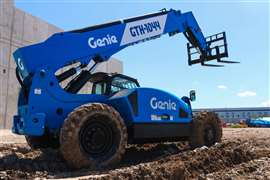Economic Outlook: North America
12 April 2011

The construction market continues to suffer from an excess inventory and little demand. While the outlook has improved, employment growth is lagging and it will still take some time for housing inventories to be depleted, excess commercial and industrial space to be absorbed and for state and local budgets to return to health.
This suggests at least one more weak year for the industry. Construction spending may make positive gains in the second half of 2011, but this would result a flat growth rate for the year as a whole. And with the market at such a deep trough in 2011, any growth would still leave output at a historically low level.
Residential
The near-term prospects for residential construction are muted as several factors dampen the market. The inventory of homes for sale remains high, as banks are insisting on 20% down payments for new homebuyers and the foreclosure process continues to add existing homes to inventory.
Record low levels of household formation are also depressing the market. Data from the Census Bureau shows that between March 2009 and March 2010, the number of households rose by 357000 - the smallest increase since comparable data began in 1947. In addition, the number of homes built increased by only 398000 the previous year, the third smallest increase on record.
Potential homeowners (and lenders) are waiting for improved employment prospects before venturing into the market. With a jobs picture that should improve by summer, some housing rebound is likely in the second half of 2011.
But it will be a prolonged recovery from a very deep hole. Starts will not return to their normal level of around 1.5 million units until 2013. Multi-family construction remains at all-time lows with nowhere to go but up.
The most recent monthly data shows a rebound in activity, but this is a notoriously volatile segment. The likely path is a slow rebound with spending levels not expected to reach those of the boom for at least the next five years.
Commercial
The broad commercial category should eke out some growth in 2011. The bellwether office segment will hold back overall growth as vacancy rates remain high, even with low rental rates. However, the recovery in financial markets has pushed forward IHS Global Insight's estimate of when new construction might be needed to the second half of 2011.
The other weak spot for commercial activity is related to the auto industry. While car sales will improve, the consolidation of dealers during the recession still suggests an excess of facilities in the market.
Other portions of the commercial market are recovering, however. Retail space will probably show positive growth as soon as the first quarter of 2011 thanks to strong retail spending by consumers in late 2010.
Lodging may also show some surprise growth in the second half of the year. This is a segment that seemed dramatically overbuilt as the recession came, but recent evidence has shown tightening vacancy rates and increasing revenue per room - the combination leading to announcements of expansion and renovations by virtually all major hotel chains.
Manufacturing construction had an awful 2010, contracting by -32.1%. The start of 2011 will not be kind, and IHS Global Insight expects this segment to slide another -10% this year.
There is good news in the form of the weak Dollar which makes US products competitive in faster growing parts of the world, particularly Asia. However, the Euro is also weak, which means more competition in export markets.
Infrastructure
Total infrastructure spending declined modestly in 2010 as deep cuts in the power sector more than offset minor gains in the highways, water and sewer segments.
The issue in 2011 will be massive fiscal shortfalls in virtually every state, particularly large ones such as California, Illinois and even Texas. Projects funded by state and local governments will face severe restrictions with water and sewer work particularly hard hit.
Highway spending will benefit from continuing federal stimulus money, although this will be the last year of significant infusions and next year could see a decline in spending.
While the Obama administration has proposed additional infrastructure spending, much of it intended for high speed rail, it is unlikely that this will pass Congress. Even if it should, it would still be several years before the initiative showed up in construction output. Indeed, states that would have seen high speed rail funding - notably Ohio and Florida - have declined federal assistance due to the lack of state funds necessary for the projects.
Healthcare construction spending fell -7.6% in 2010 as the recession conspired with continuing uncertainty over health care reform to limit new investment. Nevertheless, a growing and aging population has propelled growth in this sector every year since 2005, and positive annual growth is expected to resume.
Growth will not be as strong as in the past as budget woes weigh on the public sector that comprises over a quarter of health care construction. On the private side, a housing recovery should restart medical office demand by 2012, and an emphasis on cheaper outpatient care will continue to promote construction of specialty care buildings.
Educational building construction is in for a tougher time as public spending accounts for about 80% of funding for this segment. IHS Global Insight expects a contraction of -3.3% in 2011, followed by a period of slow growth. Demographics and migration will continue to create demand for new schools, but even with a recovery in tax revenues, the high and increasing cost of health care and retirement plans for public employees will limit the funds available for capital improvements in education.
Growth in 2012
Taken as a whole, the US construction market will contract once more in 2011. However, the worst is behind it, and some growth will return to key segments in the second half of the year - just not enough to turn the year positive.
Growth should return in a big way in 2012 - real growth could top +15%, lead by the residential sector. The hole is very deep, however, and even with several years of strong growth, it will be 2015 before the US once again cracks the US$ 1 trillion mark that it had attained for much of the past decade.
STAY CONNECTED


Receive the information you need when you need it through our world-leading magazines, newsletters and daily briefings.
CONNECT WITH THE TEAM










